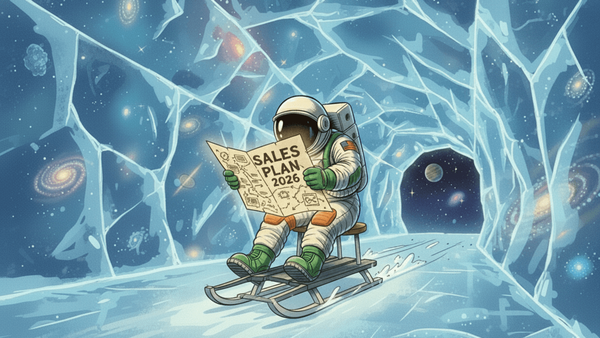Measure Sales Velocity to Fire Up Sales-Led Growth
We explain the sales velocity formula. By examining its four components —pipeline strength, win rate, sales cycle, and average deal size —you can identify ways to accelerate sales-led growth.

You've set ambitious revenue targets, but the numbers aren't materialising fast enough. Your board wants to see acceleration. Your team is working harder than ever. Yet somehow, deals keep slipping, and you're left making excuses for why the target was missed again.
You know something needs to change, but here's the problem: you're drowning in metrics. Pipeline coverage, win rates, free trial conversion rate, average deal size, sales cycle... Each tells you a fragment of the story, but none tells you what to do. You don't really know where to start fixing the situation.
The Hidden Cost of Velocity Drag
Every extra day a deal sits in your pipeline isn't just a delay; it's compounding lost opportunity. Should that 90-day sales cycle take 60 days? That is a big chunk of net new revenue just evaporating whilst you wait for legal to review contracts, procurement to process paperwork, or champions to secure internal buy-in.
Meanwhile, low win rates mean you're burning resources on deals that never close. Your sales team is chasing opportunities that weren't properly qualified, wasting countless hours on discovery calls and demos for prospects who'll eventually ghost them or go with a competitor. Small deal sizes limit your upside, forcing you to close exponentially more deals just to hit your number. A weak pipeline leaves you perpetually scrambling for new opportunities, creating a feast-or-famine dynamic that makes planning impossible.
Each of these friction points multiplies the others, creating a crisis that threatens your entire go-to-market motion. A thin pipeline, combined with low win rates, means you're constantly struggling to keep your head above water. Long sales cycles combined with small deals mean even your wins don't move the needle enough. The worst part? Traditional metrics hide this compound effect. You might celebrate a 25% win rate without realising it's dragging your entire revenue engine to a crawl.
Systematic Sales Velocity Optimisation
Sales Velocity lets you combine key sales metrics into a single KPI and start optimising performance based on data.
What is Sales Velocity?
Sales velocity is a model for identifying exactly where your process is bleeding time and money. Rather than looking at isolated metrics, it combines four interconnected components into a single measurement that reveals both the health of your pipeline and your team's effectiveness.
The formula is straightforward: (Number of Open Opportunities × Average Deal Size × Win Rate) ÷ Sales Cycle in Days. This calculation produces a daily revenue figure that shows precisely how much flows through your pipeline during a given period. When relevant, the average deal size can be replaced with customer lifetime value (CLV) or average revenue per account (ARPA).
If you have 20 deals in your pipeline, an average deal size of 5000€, a 40% win rate, and a 60-day sales cycle, your sales velocity would be: (20 × 5000€ × 0.40) ÷ 60 = 667€ per day. That's 20k€ per month (240k€ annually) flowing through your pipeline at current performance levels.
Understand the Levers in Sales Velocity?
Start by calculating your current baseline, then systematically analysing each component. Each represents a distinct lever you can pull to accelerate revenue generation.
Is your pipeline too thin? The foundation of high sales velocity starts with a robust pipeline filled with genuinely qualified opportunities. Having too few opportunities, or worse, relying on poorly qualified ones, means you’re constantly scrambling to hit targets and struggling to maintain growth. Focus on generating high-quality leads through targeted marketing or active prospecting, then rigorously qualifying them.
Having too few opportunities means you’re constantly scrambling to hit targets and struggling to maintain growth.
Are deals too small? Average deal size (CLV or ARPA) directly impacts the revenue each opportunity can deliver. Check whether current prospects match your ideal customer profile and whether working on those opportunities in the pipeline makes sense. If needed, start moving upmarket or redefine your target customer. Larger average deal sizes amplify your sales velocity without requiring additional pipeline volume. If your deals are too small, maybe sales-led growth is not for you?
Is your win rate lagging? Win rate is the percentage of opportunities successfully closed. A higher win rate indicates better sales effectiveness, a skilled team, and strict qualification. Improving win rate requires refining your sales pitch, asking the right discovery questions, doing great sales demos, and addressing common objections more effectively.
A higher win rate indicates better sales effectiveness.
Is your sales cycle too long? Sales cycle length is the average time required from creating a qualified opportunity to moving it to a closed won. The sales cycle is often the most significant opportunity for improvement, as reducing bottlenecks in your process multiplies overall performance by acting as a divider in the formula. To shorten the sales cycle, identify and eliminate bottlenecks, streamline approval processes, and automate follow-ups and tasks.
With sales velocity, identifying bottlenecks and inefficiencies becomes systematic rather than reactive.
With sales velocity, identifying bottlenecks and inefficiencies becomes systematic rather than reactive. By breaking down sales velocity into its four components, you can pinpoint exactly where your process is slowing down. This diagnostic capability allows you to make targeted improvements rather than implementing broad, unfocused changes.
Impact of Pulling the Right Sales Velocity Levers
Let's look at some examples of how acting on sales velocity components improves performance.
Above, we have an example:
- Open opportunities: 20
- Average deal size of 5000€
- Win rate: 40%
- Sales Cycle: 60 days
Sales velocity is 667€ (per day).
A) The company improves all components over time:
A 10% improvement in each of the first three levers, combined with a 10% reduction in sales cycle length, compounds into a 47% increase in overall velocity.
New sales velocity: (22 x 5500€ x 0,44) / 54 = 986€ (per day)
That's the power of systematic optimisation.
B) The company suspects they have slack in the sales cycle:
An initiative is made to shorten the sales cycle as much as possible. They successfully reduced the sales cycle to 39 days.
New sales velocity: (20 x 5000€ x 0,4) / 39 = 1026€ (per day)
The improvement paid off handsomely.
C) The company struggles to generate new opportunities:
The company hires their first SDR. They hoped to improve sales by increasing the pipeline. Pipeline size doubled, but some low-quality opportunities negatively impacted the other three components.
New sales velocity: (40 x 4000€ x 0,35) / 71 = 789€ (per day)
Sales velocity has increased, but the company now needs to improve the quality of SDR-sourced opportunities to accelerate it further.
Accelerating Your Revenue Engine
When you optimise sales velocity, everything changes. Instead of abstract pipeline discussions, you're having concrete conversations: "We're generating 2500€ daily in revenue at current performance. If we reduce our sales cycle by two weeks, that becomes £3,200 daily, adding £255,000 to annual revenue."
Your sales organisation transforms from a reactive, firefighting operation into a revenue engine.
Your sales organisation transforms from a reactive, firefighting operation into a revenue engine. Revenue forecasting shifts from guesswork to data-driven decision-making. When you know your sales velocity is 3200€ per day, you can confidently forecast close to 290 000€ in revenue for a 90-day quarter.
Sales velocity bridges the gap between pipeline activity and revenue results. It transforms somewhat abstract planning, like "we have enough opportunities," into concrete insights, such as "we're generating 2500€ daily in new revenue but need to improve this still by 5% for the next quarter. Here is how we do it."
For those managing growth targets and revenue commitments, sales velocity provides the clarity needed to make strategic decisions. When you identify that your win rate is 15% whilst industry benchmarks show 25%, improving conversion becomes your priority. When your sales cycle averages 120 days, whilst competitors operate in 60 days, cycle reduction becomes critical. The sales velocity formula makes this diagnostic work systematic rather than guesswork.
Sales Velocity as The Unifying Metric
For sales-led companies, mobilise your entire GTM organisation around a single, clear KPI: sales velocity. Make it visible and track it relentlessly.
Make sales velocity visible and track it relentlessly.
How to get started?
- Define a consistent time period for your calculations (monthly or quarterly). Using the same timeframe across multiple measurement periods allows you to track trends and identify improvements or deterioration in performance.
- Gather data directly from your CRM system and build reporting there. This ensures data accuracy and makes calculations straightforward or automated.
- Choose one sales velocity lever to start with. Instead of trying to boost all metrics simultaneously, select a single factor and run targeted experiments or initiatives.
Sales velocity can be a useful company-wide metric, but you might get more granular insights by calculating it by region, team, customer segment, or product. You could even calculate it for individual sales representatives. This granularity reveals performance variations that aggregate metrics mask. Perhaps your enterprise team is crushing its numbers, while your mid-market team struggles. Possibly your Northern European region has optimised their sales cycle to 60 days, whilst North America languishes at 90 days. These insights drive focused improvements.
Resource allocation and hiring decisions become evidence-based. Understanding your sales velocity helps you to determine when to hire additional sales reps, which customer segments to pursue, and how to allocate marketing budget more effectively. Rather than blindly expanding, you can staff your team based on data on pipeline capacity and revenue generation.
High sales velocity indicates a well-functioning sales and go-to-market organisation.
The difference between struggling to hit your number and consistently exceeding it can come down to this single metric. High sales velocity indicates a well-functioning sales and go-to-market organisation, whilst declining velocity signals friction points that need attention.




